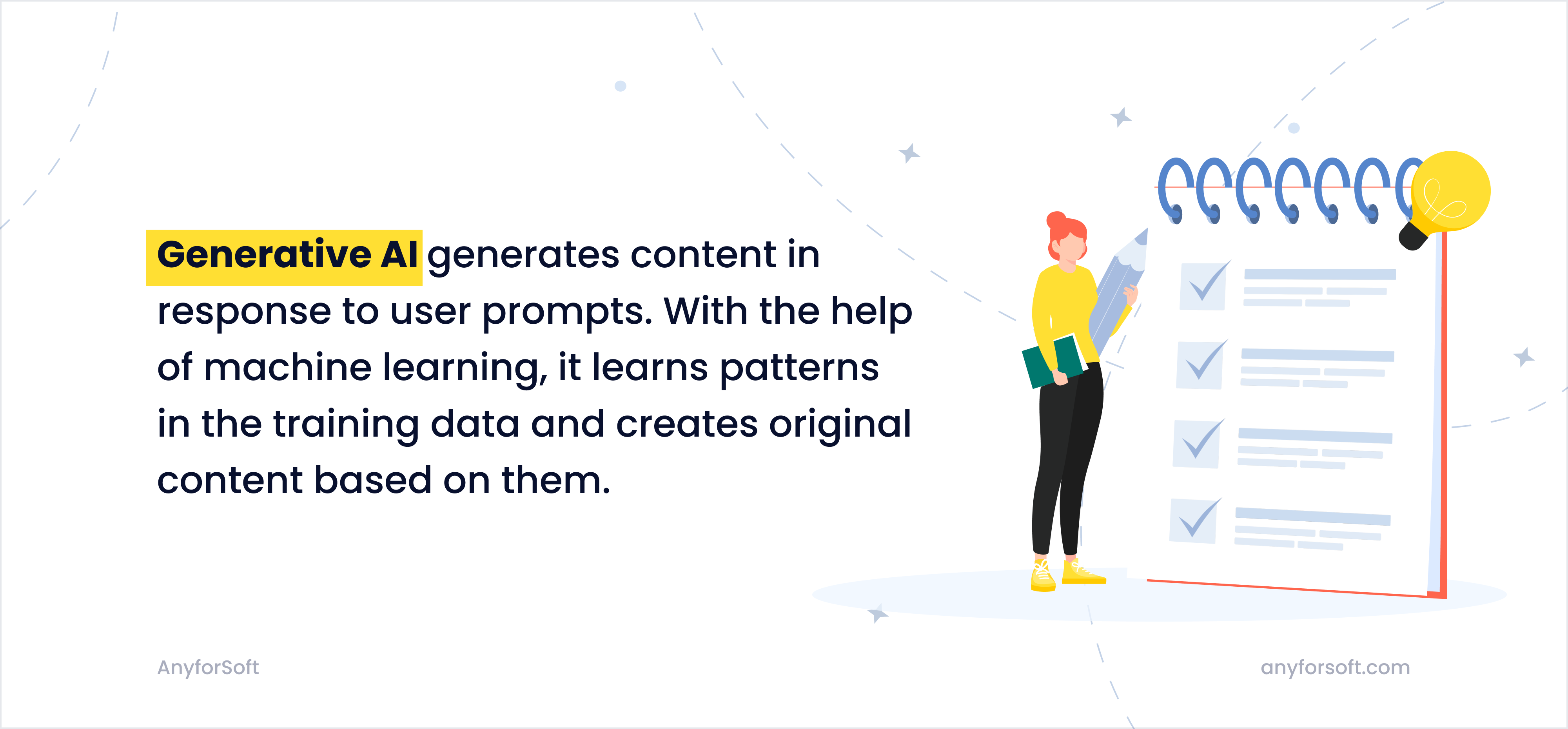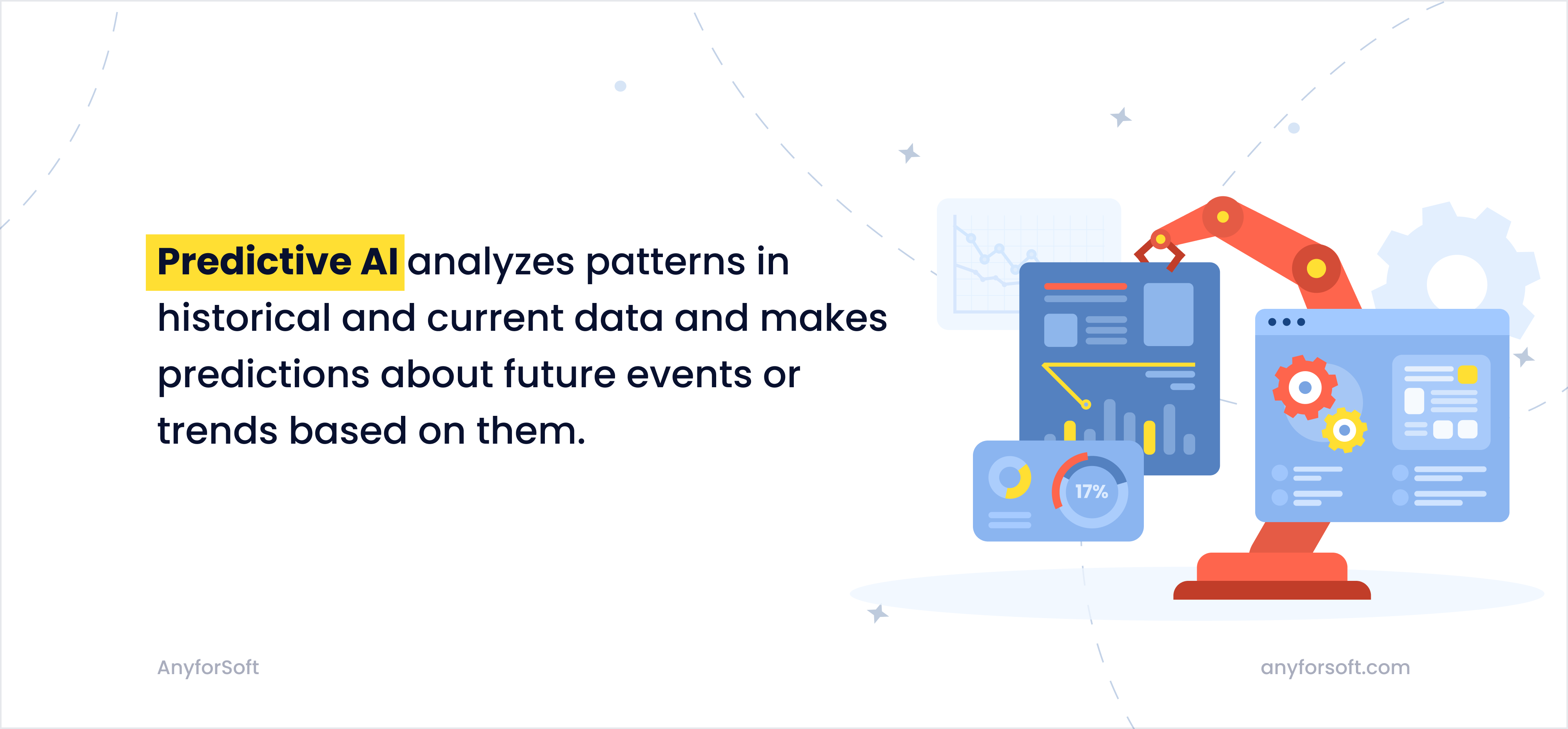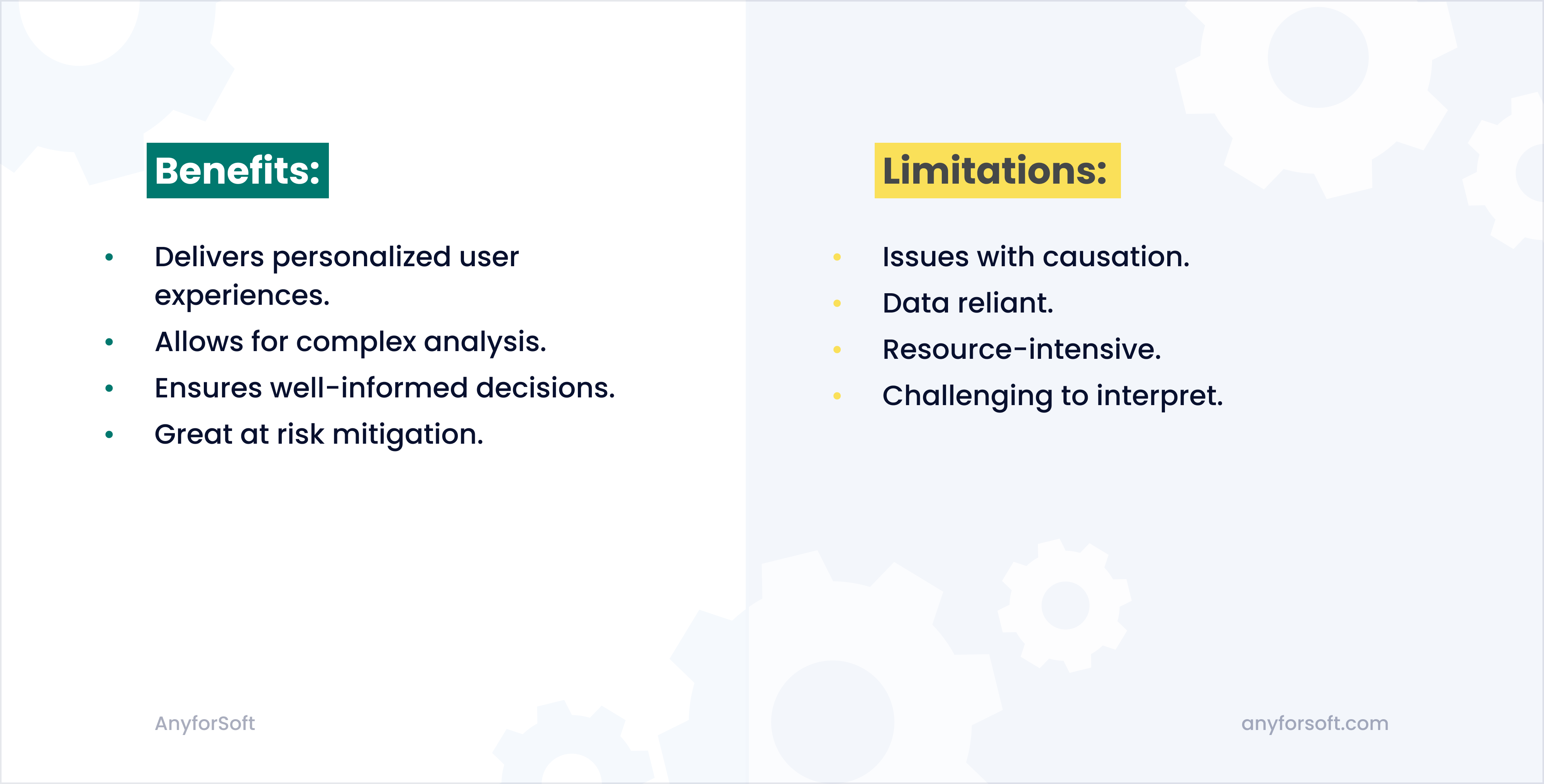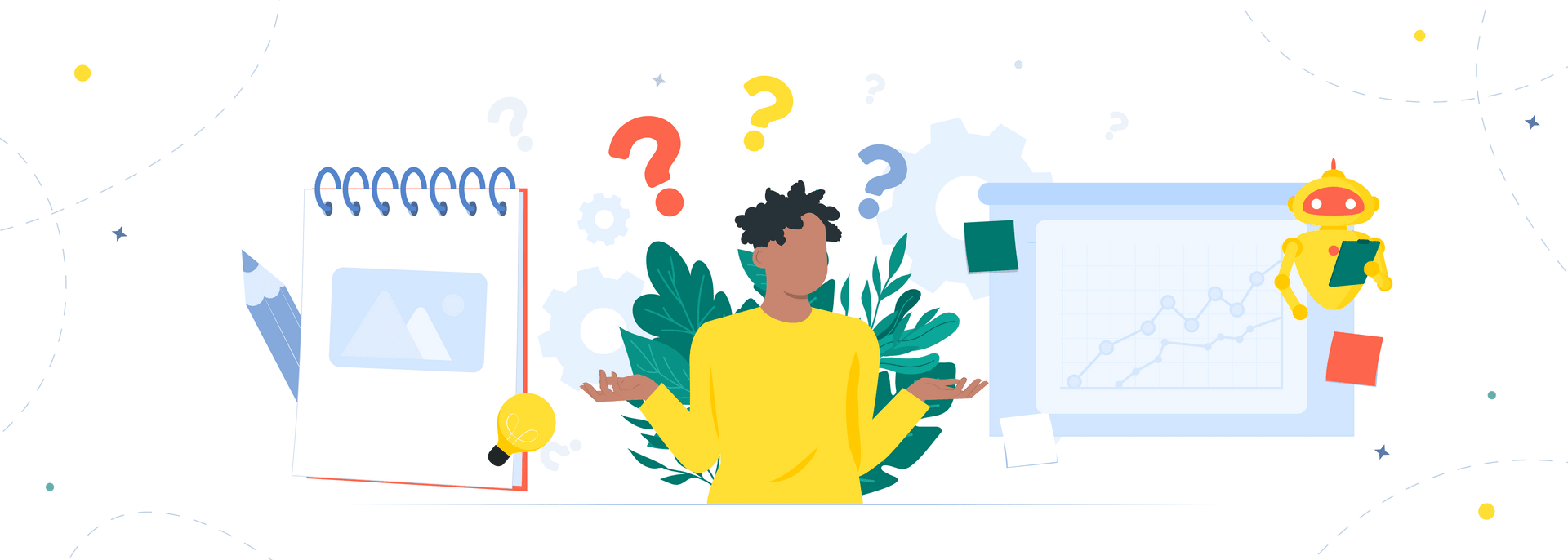Some people fear that artificial intelligence (AI) will soon take over the world and control our lives.
Well, no need to worry—it is already doing it.
Just think about it for a second: AI algorithms decide what TV show we’re going to watch next on Netflix, whether we will get approved for that bank loan, what products we will buy on Amazon, and so on and so forth.
We live in an AI-driven world, and like it or not, artificial intelligence is not going anywhere. AI technologies will continue to evolve, bringing innovation to every industry. And if you want your business to remain relevant in this ever-evolving reality, you must embrace the technology.
At some point, you will have to incorporate artificial intelligence into your company. The question is, will it be generative AI or predictive AI?
Many businesses face the “generative AI vs predictive AI” dilemma, not knowing which technology will better suit their objectives. So in today’s article, AnyforSoft would like to provide a comparative analysis of the two approaches, explaining their differences and nuances.
We’re about to discuss:
- What generative AI is and how it works;
- Its benefits and limitations;
- The applications of generative AI;
- What predictive AI is and how it works;
- Its benefits and limitations;
- The applications of predictive AI;
- The difference between generative AI and predictive AI (comparative table).
Hopefully, this article will help you solve the “predictive AI vs generative AI” issue and decide which approach is best for your business.
Without further ado, let’s get started!
What is Generative AI and How It Works
Generative AI (also called gen AI) is a type of artificial intelligence that generates new data (texts, images, videos, programming code, etc.) based on the datasets it was trained on. It does so in response to user prompts. By leveraging Generative Adversarial Networks (GANs), Variational Autoencoders (VAEs), Autoregressive models, and other machine learning technologies, it learns patterns in the training data and creates unique data based on those patterns.
The key distinctive characteristic of generative AI tools is their ability to generate completely unique content. In other words, they can create something that doesn’t explicitly exist in the training data.
One of the most popular examples of generative AI is, hands-down, ChatGPT. The model was trained using text databases from the internet. This included 570GB of data obtained from books, Wikipedia articles, and other textual content. More specifically, a whopping 300 billion words were fed into the system. As a result, ChatGPT can provide comprehensive, unique, and human-like responses to user prompts.

Benefits and Limitations of Generative AI Models
Now let’s discuss the benefits and limitations of generative AI models.
Benefits of Generative AI:
- Simplifies content creation processes and can serve as a tool for inspiration for content writers, designers, artists, musicians, and other people involved in creative work.
- Can summarize complex documents and other sets of data.
- Can work with unstructured data.
- Automates many processes. For example, it can be used for code generation; you can generate HTML tags for your text, create simple scripts, or even do complex coding.
- Provides human-like responses and can be trained to act like an expert. For example, you can create an AI-powered chatbot that will act as a support representative for your company, which would allow you to provide instant replies to client inquiries and cut customer service costs.
- Great at problem-solving. Generative AI can be used to explore potential solutions to complex problems by generating novel ideas and suggestions.
Now that we’ve discussed the advantages, let’s talk about the other side of the coin. Even though generative AI models have evolved dramatically over the years, they still have limitations.
Generative AI Limitations:
- Prone to AI hallucination (generating incorrect or misleading results). AI models generate incorrect or misleading responses for numerous reasons, including insufficient training data, biases in that data, and incorrect assumptions made by the model.
- Expensive to train. As a rule, the more datasets you feed into your model, the more accurate it will be. However, obtaining large sets of data and then organizing and structuring them is challenging, expensive, and requires substantial computational resources. What’s more, you will have to ensure there is no biased information and sensitive data in your datasets, which complicates things even further.
- Lack of understanding. Generative AI fails to understand generated content. Since it lacks comprehension, it sometimes produces outputs that seem plausible but are actually incorrect.
- Vulnerability to adversarial attacks. Generative models are susceptible to adversarial attacks, where input data is carefully crafted to mislead the model into producing incorrect or unintended outputs.

Applications of Generative AI
Despite their current limitations, generative AI models are used in a myriad of industries:
Gaming
Generative AI systems have the potential to disrupt the gaming industry and are already being used in many projects. For example, the developers of The Matrix Awakens introduced AI-powered NPCs (non-player characters) to their game. Players can communicate with them via microphone and expect human-like responses. Interestingly, these NPCs can express different emotions and even tell you to leave them alone if you are excessively annoying. Even if you’re not a gamer, you should agree that this approach is much more engaging and fun than when you interact with a scripted NPC with boring and repetitive responses.
We believe that in the near future, more games will leverage generative AI technologies, leading to immersive gaming experiences.
E-Commerce
E-commerce platforms use generative AI capabilities to create chatbots and virtual assistants. With their help, they increase user engagement, improve lead generation, collect customer data, and, most importantly, reduce customer service costs.
Let’s take Harry Rosen’s AI-powered virtual assistant Hailey as an example. When a user lands on the store, they can start a chat with this bot and ask it pretty much anything. The bot will provide a human-like response, helping the user with their inquiry.
By using an AI-powered assistant, Harry Rosen solves three issues:
- It reduces customer service costs.
- It improves user experience by providing an almost instant reply.
- It removes interpersonal communication barriers (talking to a chatbot is much easier for shy individuals than talking to a real customer support manager).
Information Technology
Generative AI tools like ChatGPT, MidJourney, DALL-E, and others are heavily used in the IT industry, as they simplify and automate many processes. Designers use them to get creative ideas for their work, generate simple layouts, etc. Content creators leverage generative AI to simplify content research, brainstorm ideas for future articles, create HTML tags for their content before publication, and so on. Marketers use such tools to create engaging email campaigns, social media posts, ad copies, and other materials. Developers refer to them for code generation, issue fixing, and other software development purposes.
AI is simplifying so many aspects of an IT specialist’s routine that it has very quickly become an integral part of the information technology industry.
What is Predictive AI and How It Works
Predictive AI (or predictive analytics) is a type of artificial intelligence that uses historical data, machine learning, and statistical algorithms to analyze patterns and make predictions about future events or trends. Unlike generative AI models, predictive AI doesn’t generate any content, which is the most significant difference between generative AI and predictive AI.
Predictive AI models have a myriad of use cases. They are used for fraud detection, financial forecasting, predicting stock market trends, credit scoring, identifying patterns in customer behavior (human behavior analysis), building recommendation systems, churn prediction, and more.
A great example of predictive AI is YouTube’s recommendation algorithm. By leveraging machine learning techniques, YouTube analyzes viewers’ habits and watch history to recommend relevant content to them. It takes into account multiple factors: which videos users tend to click on (considering its title, thumbnail, length, keywords, and topic), how much time they spend on the video, how they interact with the video (whether they leave a like or dislike, comment the video and share it), how many subscribers a channel that published the video has, and so on.
By predicting what users will likely watch next and recommending it to them, YouTube increases user retention and engagement, encouraging users to spend more time on the platform and thus making more money.

Benefits and Limitations of Predictive AI Models
To better understand the difference between predictive AI and generative AI, let’s discuss the benefits and limitations of the former.
Benefits of Predictive AI:
- Delivers personalized user experiences. By analyzing user behavior, predictive algorithms can recommend content that aligns with a specific user’s interests, improving their retention and experience.
- Allows for complex analysis. Manually analyzing large volumes of data is virtually impossible. With AI, however, companies are able to analyze and process gigabytes of data pretty quickly.
- Allows for well-informed decisions. While predictive AI models can’t predict the future with 100% accuracy, they allow companies to make well-informed decisions based on real data instead of guesswork. Besides, they eliminate errors associated with the human factor.
- Risk mitigation. Predictive AI technology enables companies to forecast future scenarios, allowing them to be prepared for any events and successfully mitigate risks.
Now it’s important to be aware of the limitations of predictive artificial intelligence to answer the “generative AI vs predictive AI” question.
Limitations of Predictive AI:
- Issues with causation. While predictive AI is great at identifying correlation, it often struggles with causation. This may lead to incorrect predictions.
- Data reliant. Both generative AI and predictive AI are data-reliant technologies. If the data used for training the system is inaccurate, biased, or incomplete, it will lead to flawed predictions.
- Resource-intensive. Just like with generative models, training predictive algorithms requires substantial computational resources, which means it is very expensive and may not be practical for certain businesses and industries.
- Challenging to interpret. When it comes to predictive models, especially complex deep neural networks, it is challenging to understand what factors AI considers to make its predictions and identify underlying biases in its decision-making process.

Applications of Predictive AI
Let's explore predictive AI applications.
Banking
Every modern bank uses predictive algorithms in its day-to-day work. Predictive AI has numerous uses in the banking industry. First and foremost, it is great at fraud detection and prevention. By analyzing the behavior of bank users, predictive AI can detect suspicious activities and prevent financial fraud before it takes place.
For example, let’s say a user’s credentials get stolen. The stealer then logs in to the stolen bank account from an unusual place (another region, city, or country). Artificial intelligence automatically identifies the anomaly and sends real-time alerts to bank personnel. They freeze the account and contact the owner, preventing the bad actor from stealing the money.
Another use case of predictive AI in banking is credit scoring. When assessing creditworthiness, traditional scoring models rely on limited data: payment history, outstanding debt, credit history length, and so on. While these models are still effective, they often limit individuals who don’t have a credit history or have non-traditional sources of income.
AI models, on the other hand, are able to analyze larger volumes of data (including non-traditional data sources such as social media activity, utility payments, and behavior data), which helps financial institutions create more accurate credit scores and adequately assess a borrower’s creditworthiness. This expands access to credit, increasing the organization’s income.
Learn more in our article about AI in fintech.
Media and Entertainment
Predictive AI goes hand in hand with the media and entertainment industry. It helps companies analyze user preferences and interests to provide content that best matches them. Let’s take Netflix, for instance. Netflix has a powerful recommendation algorithm that costs the company about a million dollars per year to maintain.
Whenever you access the platform, its recommendations system strives to help you find a show or movie that you will likely enjoy. It estimates the likelihood that you will watch a particular title in the catalog based on multiple factors:
- your interactions with Netflix (viewing history and how you rated other movies and TV shows);
- the interaction of other members who have tastes and preferences similar to yours;
- information about the titles, such as their genre, categories, actors, release year, etc.
To optimize your experience even further the platform also takes into account the time of day you watch the content, the devices you are watching Netflix on, how long you watch, and other signals. This allows Netflix to personalize the user experience, making sure that you spend more time on the platform. And the more time you spend, the more money the streaming giant makes.
Healthcare
Predictive AI models benefit the healthcare industry in multiple ways. For starters, they’re great at early detection of diseases. With the help of machine learning, these models can analyze patient data (medical history, genetics, lifestyle factors, and other parameters) and identify patients at risk of developing certain diseases. This enables healthcare organizations to intervene early and take preventive measures to stop these diseases from developing.
Another use case of predictive AI in healthcare is personalized medicine. With access to patient data, AI algorithms can tailor treatment plans based on each patient’s individual characteristics. This allows medical staff to optimize the effectiveness of the treatment plans and minimize adverse reactions.
Also, let’s not forget about accurate analysis of medical imagery. When trained properly, AI algorithms analyze X-rays, MRIs, CT scans, and other documents with high accuracy. It enables healthcare organizations to make precise diagnoses of cancer, neurological disorders, and other complex conditions.
Generative AI and predictive AI: a comparative table
Now that we’ve discussed the benefits, limitations, and applications of both generative and predictive AI, solving the “generative vs predictive AI” dilemma shouldn’t be an issue. As you can see, these systems are significantly different and thus have different purposes. However, to make the differences between generative AI and predictive AI even more clear, let’s take a look at a comparative table.
Predictive and generative AI comparison table
Generative and predictive AI: Wrapping Up
Generative AI is about content creation. It generates unique content based on the datasets it was trained on. You can think of it as your creative friend. Predictive AI is about prediction and data analysis. It analyzes patterns in current and historical data, making predictions of future events. You can think of it as your analytical friend.
While generative AI and predictive AI are significantly different, they can work in tandem in some industries.
We hope that today’s article has cleared things up for you and helped you solve the “generative AI vs predictive AI” dilemma.
In case you need help with your AI project, feel free to reach out to AnyforSoft. With over 12 years of development experience, we can turn any idea into a competitive product. Contact us today and tell us about your project.
